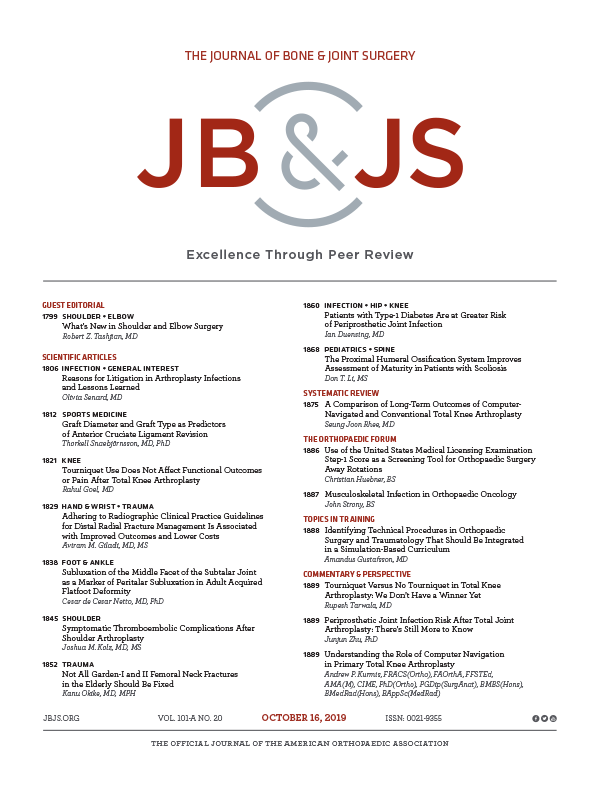
Cervical arthroplasty lead to better overall success compared to anterior fusion

Cervical arthroplasty lead to better overall success compared to anterior fusion
Results of cervical arthroplasty compared with anterior discectomy and fusion: four-year clinical outcomes in a prospective, randomized controlled trial
J Bone Joint Surg Am. 2011 Sep 21;93(18):1684-92. doi: 10.2106/JBJS.J.00476Synopsis
463 patients suffering from single-level degenerative disc disease were included in this trial to compare the outcomes of cervical disc arthroplasty and anterior cervical discectomy and fusion (ACDF). This publication aimed to assess the midterm safety and effectiveness of the Bryan cervical disc arthroplasty. 463 patients were randomized to receive either the Bryan disc or anterior cervical discectomy and fusion. The assessment at 48 months revealed that the cervical disc arthroplasty led to superior results in terms of pain, function, and overall success when compared to ACDF.
Was the allocation sequence adequately generated?
Was allocation adequately concealed?
Blinding Treatment Providers: Was knowledge of the allocated interventions adequately prevented?
Blinding Outcome Assessors: Was knowledge of the allocated interventions adequately prevented?
Blinding Patients: Was knowledge of the allocated interventions adequately prevented?
Was loss to follow-up (missing outcome data) infrequent?
Are reports of the study free of suggestion of selective outcome reporting?
Were outcomes objective, patient-important and assessed in a manner to limit bias (ie. duplicate assessors, Independent assessors)?
Was the sample size sufficiently large to assure a balance of prognosis and sufficiently large number of outcome events?
Was investigator expertise/experience with both treatment and control techniques likely the same (ie.were criteria for surgeon participation/expertise provided)?
Yes = 1
Uncertain = 0.5
Not Relevant = 0
No = 0
The Reporting Criteria Assessment evaluates the transparency with which authors report the methodological and trial characteristics of the trial within the publication. The assessment is divided into five categories which are presented below.
1/4
Randomization
2/4
Outcome Measurements
2/4
Inclusion / Exclusion
0/4
Therapy Description
3/4
Statistics
Detsky AS, Naylor CD, O'Rourke K, McGeer AJ, L'Abbé KA. J Clin Epidemiol. 1992;45:255-65
The Fragility Index is a tool that aids in the interpretation of significant findings, providing a measure of strength for a result. The Fragility Index represents the number of consecutive events that need to be added to a dichotomous outcome to make the finding no longer significant. A small number represents a weaker finding and a large number represents a stronger finding.
Why was this study needed now?
Cervical arthroplasty can be an alternate treatment option to anterior cervical discectomy and fusion for patients suffering from single-level degenerative disc disease. A previous publication by the same authors reported the 2 year results from a trial that compared the Bryan cervical disc arthroplasty with anterior cervical discectomy and fusion. While cervical disc arthroplasty lead to better overall success, a longer follow-up study was required. Thus, this publication aimed to compare the 4 year clinical and functional outcomes of cervical disc arthroplasty versus cervical discectomy and fusion from the same trial.
What was the principal research question?
Which method - cervical spine arthroplasty or anterior cervical discectomy and fusion - led to better overall success for the treatment of radiculopathy or myelopathy caused by single-level cervical disc disease, assessed at 48 months?
What were the important findings?
- At 4 years, the overall success was better in the arthroplasty group (85.1%) compared to the fusion group (72.5%) (P = 0.004).
- At 4 years, the mean NDI was lower in the arthroplasty group (13.2 (95% CI: 10.9 to 15.6)) in comparison to the fusion group (19.8 (95% CI: 16.5 to 23.2), P < 0.001).
- In terms of neurological success, the mean rates were 92.8% for the arthroplasty group and 89.9% for the fusion group; there was no significant difference (P > 0.05).
- The arm pain score improved rapidly for both groups, from a preoperative score of 71.2 in both groups to 16.6 (95% CI: 13.1 to 20.2) in the arthroplasty group and to 22.4 (95% CI: 17.7 to 27.1) in the fusion group at 4 years; the improvement was significantly better in the arthroplasty group (P = 0.028).
- Neck pain improved from 75.4 to 20.7 (95% CI: 17.0 to 24.4) in the arthroplasty group and from 74.8 to 30.6 (95% CI: 25.5 to 35.8) in the fusion group at 4 years; the improvement was significantly greater in the arthroplasty group at all time points (P < 0.05).
- At 4 years, the mean SF-36 physical component score improvement was significantly better (P = 0.007) in the arthroplasty group (from 32.6 to 48.4 (95% CI: 46.8 to 49.9) compared to the fusion group (from 31.8 to 44.9 (95% CI: 43.0 to 46.9).
- The rates of total and serious adverse events were similar between both groups.
What should I remember most?
This study demonstrated that cervical disc arthroplasty continued to provide superior results at 4 years in comparison to anterior cervical discectomy and fusion. The arthroplasty treatment led to significantly higher rate of overall success and greater improvements in NDI, neck and arm pain, and SF-36 physical component scores.
How will this affect the care of my patients?
This study suggests that cervical disc arthroplasty provides better clinical improvement compared to cervical fusion. However, a longer-term follow-up study is required in order to investigate the potential problems related to bearing surface wear. Additionally, an assessment of adjacent-level disc degeneration and secondary surgeries should be conducted in the long-term follow-up.
Learn about our AI Driven
High Impact Search Feature
Our AI driven High Impact metric calculates the impact an article will have by considering both the publishing journal and the content of the article itself. Built using the latest advances in natural language processing, OE High Impact predicts an article’s future number of citations better than impact factor alone.
Continue



 LOGIN
LOGIN

Join the Conversation
Please Login or Join to leave comments.